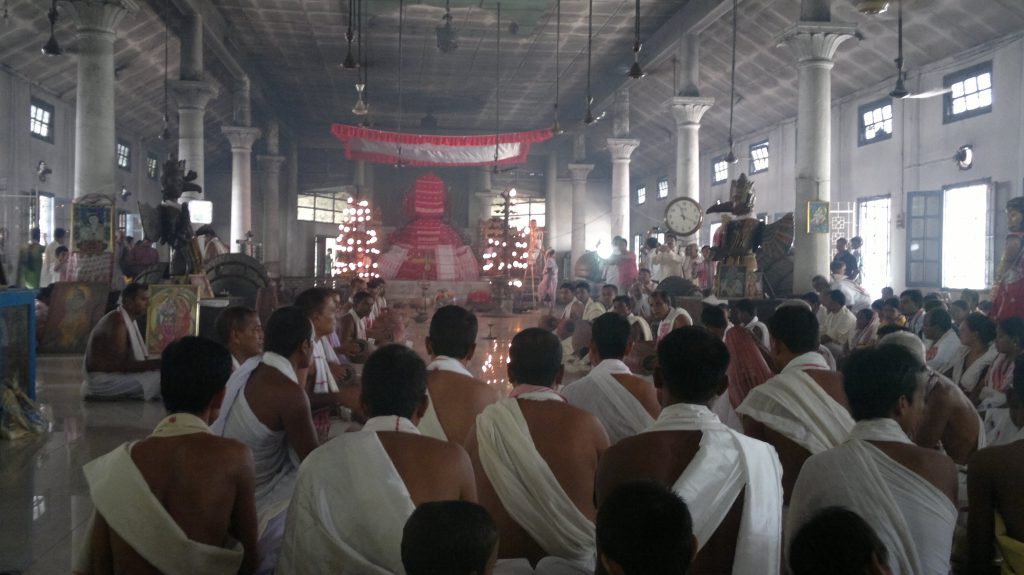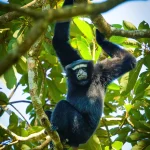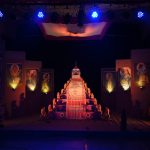Srimanta Sankaradeva was one of the foremost religious philosophers in the world. His religion Eka Sharana Nâma Dharma laid the foundation for a new religious philosophy. The present author has named this philosophy as Vivartanavâda as it facilitates the elevation of the Jîva from the primary dual state to the non-dual state of identity with Brahma. The pertinent features of this philosophy are :
(1) Brahma is the supreme truth. It is shapeless and beyond all attributes.
(2) Brahma and Ishwara (God) are the same, even though Iswara is the abode of all attributes.
(3) Brahma or Ishwara is there in every being.
(4) Ishwara and His creations are not different.
(5) Jîva (creature) is a component of God. The former constitutes the body of the latter.
(6) The creation is temporary, but not unreal.
(7) Mâyâ (illusion) is an attribute of God and its influence can be avoided by the grace of God.
(8) One becomes God as one realises the identity of God and the five elements.
A major characteristic of Srimanta Sankaradeva’s philosophy is that it preaches equality of the Nirguna Brahma and Saguna Ishwara. He says this categorically in a verse of his magnum opus Kirtana-ghoshâ,
Tumi Paramâtmâ jagatara Isha eka
Eko bastu nâhike tomâta byatireka
(Kirtana-ghoshâ / 519)
[Meaning : You are the universal self as well as the one supreme God of the creation. There is nothing other than you.]
The Paramâtmâ or universal self, which is beyond all attributes and the Iswara, the supreme God, Who is the abode of all virtues are the same. No other branch of Sanâtana Indian philosophy had taken this position before Srimanta Sankaradeva. That was why the branches of Jnâna Mârga (path of knowledge) and Bhakti Mârga (path of devotion) had always remained wide apart in Sanâtana Hinduism. It was Srimanta Sankaradeva, who brought these two paths together; thus he did a great service to Sanâtana Hinduism. He declared the importance of spiritual knowledge in a verse of his book Nimi navasiddha sambâda,
Howe jnânasunya / kona pâpa punya / karite napâre sâra
Bishaya byâkula / samyake bâtula / nuguche jâtanâ târa
(Nimi navasiddha sambâda / 56)
[Meaning : One who is devoid of knowledge, cannot differentiate between vice and virtue. He gets totally immersed in mundane affairs like a mad man and his woes never end.]
Srimanta Sankaradeva differed from the great monist saint, Adi-Sankaracharya in his attitude towards creation. Adi-Sankaracharya declared the Jagat or creation as Mithyâ or false. For him, Brahma alone was true. He said, Brahma Satya Jagat Mithyâ. But Srimanta Sankaradeva treated the Jagat as the play-field of God. And the object, which God relishes in cannot be untrue. Srimanta Sankaradeva said in his transcreation of Bhâgavata,
Tumi Brahma tattva jagata jateka
tomârese krirâ bhânda
(Bhâgavata / 3 / 157)
[Meaning : You are the supreme entity, Brahma. The entire creation is nothing but your play-field.]
According to Adi-Sankaracharya, even Ishwara is Mâyâ or false. He said,
Ekâbupâdhi parajivayostayoh
Samyangnivâse na paro na jivah
(Vivekachurâmani / 244)
Adi-Sankaracharya denied the existence of the Saguna Ishwara. He acknowledged the existence of only Nirguna Brahma. He said categorically in his commentary of Brahmasutra,
Samasta bishesharahitang nirbikalpameba
Brahma pratipattabyang na tadbiparitam
(Brahmasutra Bhâshya / 3 / 2 / 11)
But Srimanta Sankaradeva considered Ishwara as non-different from Brahma. For him, Ishwara was above Mâyâ. He categorically said that Bhagavanta or Ishwara was the supreme entity as described in the Vedânta. He said in his transcreation of Bhâgavata,
Jito prakritita para prabhu Bhagavanta
Vedântaro mukhya bhâge jâka prakâshanta
(Bhâgavata / 10 / 469)
[Meaning : God is above the Prakriti or creation. The main content of Vedânta expresses Him only.]
Since the monists like Adi-Sankaracharya did not think in this line, Ishwara was different from Brahma for them. So devotion to any entity including Ishwara could not be supported by their monistic theory. But Adi-Sankaracharya did exactly that, when he worshipped five deities. That means he did not practise his own monism. His theory was impractical. But Srimanta Sankaradeva’s theory was practicable because he equated Brahma with Ishwara.
The monists make attempt to surmount Mâyâ by making auto-suggestions like Ahang Brahmâsmi (I am Brahma), Tattvamasi (Thou art that) etc. One’s purpose here is to identify oneself with Brahma. But Srimanta Sankaradeva advised the devotees to worship God in order to get His blessings so that God’s Mâyâ could be surmounted. He said this in a verse of his Kirtana-ghoshâ,
Harinâma hiye dhari Harinâma sadâ smari
Tebese Harira Mâyâ tari
(Kirtana-ghoshâ / 599)
[Meaning : We can surmount Mâyâ only by holding the name of lord Hari in our heart and chanting His name always.]
Srimanta Sankaradeva considered the human body as a holy tool for worshipping God. Such a precious body could be had only after numerous births, he said. (Bhakti Ratnâkara) The creation was treated by Srimanta Sankaradeva as a play-field of God. He did not share the negative Neti Neti Neti approach of the monists towards the creation. He sought to explain every thing positively. Here he departed from the Upanishadic tradition. The positive attitude of Srimanta Sankaradeva helped him in his reformist social movement. He did not renounce the world, but worked for the upliftment of the world.
Srimanta Sankaradeva’s philosophy had elements of both Parinâmavâda and Vivartavâda. He considered Jîva as a changed form of Ishwara. This is an element of Parinâmavâda. In other words, it is a departure from monism. But at the same time Srimanta Sankaradeva also alluded to the illusion of snake in rope, while refering to the creation. This is an element of Vivartavâda. So his philosophy Vivartanavâda cannot be categorized exclusively as either Parinâmavâda or Vivartavâda. He blended Parinâmavâda and Vivartavâda in his Vivartanavâda. The way he blended these two elements is a unique thing. Such a blending is not seen in other philosophers.
The way Srimanta Sankaradeva termed Ishwara as different from Jîva is a clear proof that he was not a pure monist. He termed Ishwara as Uttama Purusha (Best man) and Jîva as Adhama Purusha (Worst man). (Bhâgavata 11 / 78) This is a clear evidence that the saint considered Ishwara and Jîva as different entities. But this difference disappears at the time of dissolution of the creation, according to Srimanta Sankaradeva. He says that at that point, the Jîva merges in Ishwara. (Anâdi Pâtana / 50) This approach is different from that of Maddhacharya, for whom the difference between Ishwara and Jîva persists.
Another feature of Srimanta Sankaradeva’s blending Parinâmavâda and Vivartavâda is that while he termed Ishwara and devotee as different, he also accepted the identity of both in the final analysis. Such a feature is seen in Dvaitâdvaitavâda of Nimbarka also. But Nimbarka was a strict believer of Parinâmavâda, which refutes his theory of identity between Ishwara and devotee. Moreover he worshipped dual entities, which is different from tenets of Eka Sharana Nâma Dharma preached by Srimanta Sankaradeva.
Achintya Bhedâbhedavâda, the philosophy of Chaitanyadeva is almost akin to Nimbarka’s. Moreover Achintya Bhedâbhedavâda could not explain the identity and duality of Ishwara and Jîva at the same time; they just declared it to be beyond all interpretations. Against that, Srimanta Sankaradeva explained that paradox successfully.
Srimanta Sankaradeva’s philosophy also differed from that of Ramanuja, the proponent of qualified monism. Ramanuja considered Brahma as summation of all sentient and insentient beings. (Sri Bhâshya 2 / 2 / 33) But Srimanta Sankaradeva talked about a different relationship between Jîva and Ishwara. He treated Jîva as equivalent to Ishwara, since Ishwara permeates all beings. The saint enjoined upon every one to treat all beings as manifestations of lord Vishnu. (Kirtana-ghoshâ / 1820) Ramanuja did not share this perspective of Srimanta Sankaradeva. Ramanuja analysed the sentient and insentient beings differently. He did not accept their identity or equality.
Another difference of Srimanta Sankaradeva’s philosophy from that of Ramanuja lies in their distinct perspectives about Brahma. While Srimanta Sankaradeva termed Brahma as shapeless and beyond all attributes, Ramanuja termed Brahma as only attributeful and equipped with a body. For him, the universe constitutes the body of Brahma. (Sri Bhâshya 1 / 1 / 1, 1 / 4 / 27)
Both Srimanta Sankaradeva and Ramanuja accepted the existence of Brahma inside every creature. But there is a subtle difference between them regarding their conception of the ultimate end of the creatures. Srimanta Sankaradeva believed in the ultimate merger of all entities in Brahma at the end of Kalpa (the cycle of existence). But according to Ramanuja, the creatures remain appended to and united with Brahma in a subtle form at the end of Kalpa; they do not merge in Brahma. Here Srimanta Sankaradeva is more close to monism, which accepts Brahma as the ultimate reality. Nevertheless, Srimanta Sankaradeva did not consider it important for the devotees to strive for merger with Brahma; instead his ideology stressed on inculcating devotion to Ishwara. In that respect, he is similar to Ramanuja or for that matter any other devotional philosopher.
The more prominent difference of Srimanta Sankaradeva’s philosophy with that of Ramanuja lies in the fact that Ramanuja abided by Parinâmavâda predominantly. Contrary to that, Srimanta Sankaradeva’s philosophy Vivartanavâda had elements of both Parinâmavâda and Vivartavâda, as explained above. The same consideration differentiates Srimanta Sankaradeva’s philosophy from the Shuddhâdvaitavâda of Vallabhacharya, who also abided by Parinâmavâda.
In fact Srimanta Sankaradeva’s philosophy is not similar to any devotional philosophy, because none of those devotional philosophies preached the tenet of Eka Sharana like him. Eka Sharana means submission to a single ultimate supreme entity, which happens to be lord Krishna in Srimanta Sankaradeva’s case. He strictly forbade worship of any other entity. But we see that other devotional cults advocate worship of a female entity also along with a supreme entity. Thus Radha, Rukmini, Sita, Lakshmi etc are worshipped in these orders along with Krishna, Vitthala, Rama, Narayana etc. Even the Alwars worshipped the female deities Lakshmi, Sri and Bhu.
Srimanta Sankaradeva’s philosophy is an integral philosophy as it contains elements from different perspectives. It became possible only because he had an integral view of life. He equated Brahma and Ishwara. It is significant that he paid obeisance to the eternal entity in the form of Brahma at the very outset of his book Kirtana-ghoshâ. His philosophy could facilitate a journey from the gross to the subtle for the devotee as it covers ideas ranging from dualism to monism. We have named this philosophy as Vivartanavâda considering its stress on spiritual evolution of the devotee from gross to subtle, from plurality to non-duality.
Evolution is an important theme in Srimanta Sankaradeva’s writings. In fact he started his Kirtana-ghoshâ with descriptions of the incarnations of Ishwara. These incarnations are nothing but metaphors for different phases of development of the creatures. So Srimanta Sankaradeva highlighted the process of evolution. He accommodated beliefs of all stages in his philosophy, so that any devotee could rise through that philosophical system, whatever be the philosophical state of the devotee. Starting from the devotees of primary level upto the devotees of the highest order of non-dual realization, everyone felt at home in the philosophical system of Eka Sharana Nâma Dharma.
The religious philosophy preached by Srimanta Sankaradeva had its genesis in the Vedas. There are many explicit references to Veda in Srimanta Sankaradeva’s own writings. He glorified the Vedas in many places of his innumerable writings. He advised people to follow the path of the Vedas. In order to explore the similarity of Srimanta Sankaradeva’s ideology with the Vedic thoughts, we will have to analyse the Purusha-sukta of Rigveda. The Purusha-sukta of Rigveda is an important exposition on Brahma. It says that the ultimate Purusha pervades every entity, both sentient and insentient beings. He is the past and present of every thing and the controller of all beings. This universe is his attribute. He can be known by surmounting ignorance. So he is the Paramâtmâ. All deities emanate from him. Actually all these deities are nothing but metaphorical representation of the nature. This is explained beautifully by the Bâgambrini-sukta of Rigveda.
So the Vedic idea about the deities is the same as that of Srimanta Sankaradeva, who considered the deities as subservient to the supreme God. That the Eka Sharana Nâma Dharma is also known as Mahâpurushîyâ Dharma is significant in this context. This nomenclature itself means that Srimanta Sankaradeva preached devotion and allegiance to one supreme absolute entity in the line of Purusha-sukta of Rigveda.
Another important feature of the Purusha-sukta is that it placed Vâsudeva in the highest pedestal, which was also what Srimanta Sankaradeva did. According to the Purusha-sukta, the universe emanated from Vâsudeva, which means that Vâsudeva is the supreme God. Vâsudeva is none but lord Krishna. Vâsudeva means son of Vasudeva. In other words Vâsudeva means lord Krishna. That is why lord Krishna is worshipped as the supreme God in the Eka Sharana Nâma Dharma.
The philosophy of Srimanta Sankaradeva that there is one supreme being is in tune with the philosophy of the Vedas. It was said categorically in the Rigveda that one supreme being existed in all entities of the universe. This supreme being is called by different people by different names.
Ekang sat viprâ bahudhâ badanti
(Rigveda/1/164/46)
Moreover the work of the Vedas did not end in the declaration of the existence of that supreme being. The seers of the Vedas sang the glory of chanting the names of lord Vishnu too.
Om Asya jânanto nâma chidbivaktan mahaste Vishno sumating bhajâmahe
(Rigveda/1/156/3)
It is said in this verse that the name of lord Vishnu is consciousness itself; the chanting of lord Vishnu’s name begets devotion. So the tradition of singing the name of lord Vishnu or lord Hari in the Eka Sharana Nâma Dharma is in tune with the main concept of the Vedas. The Vedic tradition of devotion to lord Hari, and chanting the name of lord Hari had been relegated to a secondary status following the rise of the Âgama path. The leaders of Karma-kânda had suppressed the Vedic tradition of devotion to lord Hari, for which Srimanta Sankaradeva expressed deep regret. He wrote in the chapter, Bhâgavata Tâtparjya of his Kirtana Ghoshâ,
Satya juge prathamata Brahma âdi deva jata
Hari nâma karile guputa
(Kîrtana-ghoshâ/2020)
[Meaning : All the deities including Brahma hid the name of lord Hari at the outset of the Satya era.]
It has been said in the Rigveda that only lord Vishnu should be worshipped.
Vishnorno kang birjani pra bochang jah parthibani bimame rajangsi
Jo askabhayaduttarang sadhasthang bichakramanastredhorugaya
(Rigveda 1/154/1)
This means that all creatures are created and cared for by lord Vishnu; all of them merge in the Lord at the end. So only lord Vishnu deserves to be worshipped. It is thus abundantly clear that the true Vedic religion was preserved in the Eka Sharana Nâma Dharma only.
Earlier published in www.sankaradeva.com




